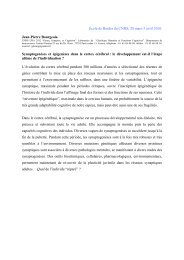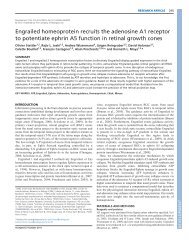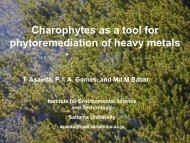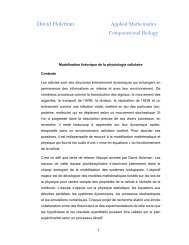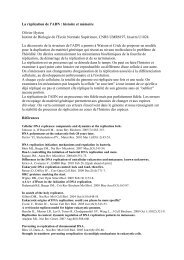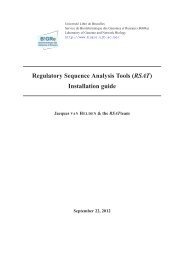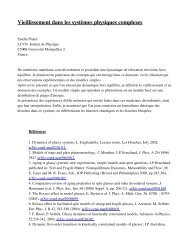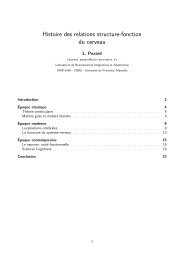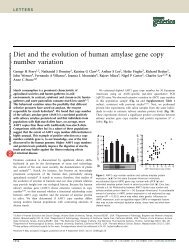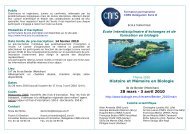Processing of Intron-Encoded Box C/D Small Nucleolar RNAs ...
Processing of Intron-Encoded Box C/D Small Nucleolar RNAs ...
Processing of Intron-Encoded Box C/D Small Nucleolar RNAs ...
You also want an ePaper? Increase the reach of your titles
YUMPU automatically turns print PDFs into web optimized ePapers that Google loves.
MOLECULAR AND CELLULAR BIOLOGY, July 2000, p. 4522–4531 Vol. 20, No. 13<br />
0270-7306/00/$04.000<br />
Copyright © 2000, American Society for Microbiology. All Rights Reserved.<br />
<strong>Processing</strong> <strong>of</strong> <strong>Intron</strong>-<strong>Encoded</strong> <strong>Box</strong> C/D <strong>Small</strong> <strong>Nucleolar</strong> <strong>RNAs</strong><br />
Lacking a 5,3-Terminal Stem Structure<br />
XAVIER DARZACQ AND TAMÁS KISS*<br />
Laboratoire de Biologie Moléculaire Eucaryote du CNRS, 31062 Toulouse, France<br />
Received 16 February 2000/Returned for modification 31 March 2000/Accepted 6 April 2000<br />
The C and D box-containing (box C/D) small nucleolar <strong>RNAs</strong> (sno<strong>RNAs</strong>) function in the nucleolytic processing<br />
and 2-O-methylation <strong>of</strong> precursor rRNA. In vertebrates, most box C/D sno<strong>RNAs</strong> are processed from<br />
debranched pre-mRNA introns by exonucleolytic activities. Elements directing accurate snoRNA excision are<br />
located within the snoRNA itself; they comprise the conserved C and D boxes and an adjoining 5,3-terminal stem.<br />
Although the terminal stem has been demonstrated to be essential for snoRNA accumulation, many sno<strong>RNAs</strong><br />
lack a terminal helix. To identify the cis-acting elements supporting the accumulation <strong>of</strong> intron-encoded box<br />
C/D sno<strong>RNAs</strong> devoid <strong>of</strong> a terminal stem, we have investigated the in vivo processing <strong>of</strong> the human U46 snoRNA<br />
and an artificial snoRNA from the human -globin pre-mRNA. We demonstrate that internal and/or external<br />
stem structures located within the snoRNA or in the intronic flanking sequences support the accumulation <strong>of</strong><br />
mammalian box C/D sno<strong>RNAs</strong> lacking a canonical terminal stem. In the intronic precursor RNA, transiently<br />
formed external and/or stable internal base-pairing interactions fold the C and D boxes together and therefore<br />
facilitate the binding <strong>of</strong> snoRNP proteins. Since the external intronic stems are degraded during snoRNA<br />
processing, we propose that the C and D boxes alone can provide metabolic stability for the mature snoRNA.<br />
The nucleolus contains a large number <strong>of</strong> small nucleolar<br />
<strong>RNAs</strong> (sno<strong>RNAs</strong>), which function in the nucleolytic processing<br />
and nucleotide modification <strong>of</strong> precursor r<strong>RNAs</strong> (prer<strong>RNAs</strong>)<br />
(reviewed in references 34, 48, and 49). The vast<br />
majority <strong>of</strong> sno<strong>RNAs</strong> fall into two families, which can be distinguished<br />
on the basis <strong>of</strong> common sequence boxes. Many<br />
sno<strong>RNAs</strong> share the conserved C (consensus sequence: RUG-<br />
AUGA) and D (CUGA) boxes (50; reviewed in reference 34),<br />
and the rest <strong>of</strong> the sno<strong>RNAs</strong> possess the H (AnAnnA) and<br />
ACA motifs (4, 16). A few C and D box-containing (box C/D)<br />
sno<strong>RNAs</strong> (U3, U8, U14, and U22) and an H and ACA motifcontaining<br />
(box H/ACA) snoRNA (snR30) are required for<br />
the production <strong>of</strong> mature-sized r<strong>RNAs</strong> (21, 22, 30, 35, 40, 46,<br />
53). However, the majority <strong>of</strong> box C/D and box H/ACA snoR-<br />
NAs direct site-specific 2-O-ribose methylation (10, 26, 32, 51)<br />
and pseudouridylation (17, 37) <strong>of</strong> r<strong>RNAs</strong>, respectively.<br />
Genes coding for sno<strong>RNAs</strong> have been found in diverse<br />
genomic contexts (reviewed in references 34, 49, and 59).<br />
While the majority <strong>of</strong> vertebrate sno<strong>RNAs</strong> are synthesized as<br />
parts <strong>of</strong> pre-mRNA introns, most yeast and plant sno<strong>RNAs</strong><br />
are transcribed as monocistronic or polycistronic precursor<br />
sno<strong>RNAs</strong> (pre-sno<strong>RNAs</strong>) from independent transcription<br />
units. In each case, mature sno<strong>RNAs</strong> are released from the<br />
primary transcript by nucleolytic processing. The intronic<br />
sno<strong>RNAs</strong> are processed from the removed and debranched<br />
host introns (23, 25, 39, 41) or, less frequently, from endonucleolytically<br />
released intronic fragments (7, 15, 42, 55) by exonucleolytic<br />
activities (2, 9, 11, 23–25, 41, 52). From yeast polycistronic<br />
pre-snoRNA transcripts, the RNase III (Rnt1p)<br />
endoribonuclease releases individual pre-snoRNA fragments<br />
and, again, exonucleolytic trimming forms the correct 5 and 3<br />
termini <strong>of</strong> the snoRNA (12, 13, 43). The yeast Rat1p and<br />
Xrn1p 533 exonucleases play an essential role in the 5-end<br />
formation <strong>of</strong> both intronic and polycistronic sno<strong>RNAs</strong> (41, 43,<br />
* Corresponding author. Mailing address: Laboratoire de Biologie<br />
Moléculaire Eucaryote du CNRS, 118 route de Narbonne, 31062 Toulouse,<br />
France. Phone: (33) 5 61 33 59 91. Fax: (33) 5 61 33 58 86.<br />
E-mail: tamas@ibcg.biotoul.fr.<br />
55). Maturation <strong>of</strong> some yeast sno<strong>RNAs</strong> by trimming <strong>of</strong> short<br />
3-terminal trailer sequences specifically requires the Rrp6p<br />
335 exonuclease that is a component <strong>of</strong> the yeast exosome<br />
(1, 2).<br />
The exonucleolytic processing <strong>of</strong> intronic and polycistronic<br />
sno<strong>RNAs</strong> is directed by cis-acting elements which have been<br />
found within the snoRNA itself. Consistent with this finding,<br />
sno<strong>RNAs</strong> placed into nonnatural sequence contexts are accurately<br />
processed both in vitro and in vivo (5, 16, 17, 25–27, 44,<br />
57, 60). The conserved sequence boxes and the neighboring<br />
stem structures constitute the signal elements directing the<br />
correct snoRNA formation (4, 6, 9, 16, 20, 44, 57, 60). <strong>Processing</strong><br />
and accumulation <strong>of</strong> the intron-encoded and polycistronic<br />
box C/D sno<strong>RNAs</strong> depend on the C and D boxes<br />
and an adjacent 4- or 5-bp helix that folds together the 5<br />
and 3 ends <strong>of</strong> the sno<strong>RNAs</strong>. This terminal structure, called<br />
the box C/D core motif (57, 60), functions as a binding site for<br />
snoRNP core proteins (8, 28, 33, 58). Most probably, snoRNA<br />
proteins bound to the pre-snoRNA protect the snoRNA sequences<br />
from the processing exonucleases and therefore delineate<br />
the correct snoRNA termini and provide metabolic<br />
stability for the mature snoRNA.<br />
Several laboratories have demonstrated that a base-paired<br />
5,3-terminal stem is absolutely required for the processing<br />
and accumulation <strong>of</strong> box C/D sno<strong>RNAs</strong> (6, 9, 20, 31, 57, 60).<br />
However, mysteriously enough, many intron-encoded box C/D<br />
sno<strong>RNAs</strong> expressed in mammalian cells (26, 54) or polycistronic<br />
sno<strong>RNAs</strong> accumulating in yeast (32) lack the canonical<br />
5,3-terminal helix. Elements supporting the processing and<br />
accumulation <strong>of</strong> this large group <strong>of</strong> box C/D sno<strong>RNAs</strong> remain<br />
largely speculative. In this study, we demonstrate that processing<br />
<strong>of</strong> mammalian box C/D sno<strong>RNAs</strong> lacking a 5,3-terminal<br />
stem is supported by external intronic stem structures that are<br />
fully or partially degraded during the exonucleolytic processing<br />
<strong>of</strong> these sno<strong>RNAs</strong>.<br />
MATERIALS AND METHODS<br />
General procedures and oligos. Unless stated otherwise, all techniques used<br />
for manipulating DNA, RNA, and oligodeoxynucleotides (oligos) were per-<br />
4522
VOL. 20, 2000 PROCESSING OF BOX C/D sno<strong>RNAs</strong> 4523<br />
formed according to standard laboratory protocols (45). The following oligos<br />
were used in this study: 1, ATAATCGATGTAGGGTGATGAAAAAGAATC<br />
CTTAGGCG; 2, ATAACGCGTAGTCAGTGTAACTATGACAAG; 3, ATAA<br />
TCGATGGAGGCAAGTAGGGTGATGAAAAAGAATCC; 4, ATAACGCG<br />
TGGAGGCAACAGTCAGTGTAAC; 5, ATAATCGATGGCGCCTCGCGTC<br />
ATAGTCAG; 6, ATACTCGAGACCAAGGAGAGCAAGGCAAGTGAG<br />
GG; 7, ATAATCGATCTCTATTCGTAGGGTGATGAAAAAGAATCC; 8,<br />
ATAACGCGTCTCTATTCCAGTCAGTGTAACTATG; 9, CGATGCAACA<br />
GCATGATGATCGACCGC; 10, GGTAAGATCTCTGATCAATGATGACA<br />
TATGGTCAAG; 11, TCCATTTACCTGACTGTTGCA; 12, TTGATCAGAG<br />
ATCTTACCGCGGTCGATCATCATGCTGTTGCAT; 13, CGCGTGCAACA<br />
GTCAGGTAAATGGACTTGACCATATGTCATCA; 14, ATAATCGATTCG<br />
AGACATGATGATCGACCGCGG; 15, ATAACGCGTGCAACAGTCAGAT<br />
AAATGG; 16, ATAATCGATCAAGAGACATGATGATCG; 17, ATAATCG<br />
ATTGCAAGAGACATGATGATGCG; 18, ATAATCGATCGTGCAAGAGA<br />
CATGATGATCG; 19, ATAATCGATCGCGTGCAAGAGACATGATGATC<br />
GACCGCGG; 20, ATAATCGATTCGACACATGATGATCGACCGCGG; 21,<br />
CGCGTGCAACAGTCAGGTAAATGACCGCGGTCA; 22, TATGACCGCG<br />
GTCATTTACCTGACTGTTGCA; and 23, GGCCACAACCACGCCTAAGG.<br />
Construction <strong>of</strong> plasmids for transfection <strong>of</strong> COS7 cells. Construction <strong>of</strong> the<br />
pGL CXM mammalian expression vector has been described elsewhere (25). In<br />
brief, the human -globin gene carrying three novel restriction sites (ClaI, XhoI,<br />
and MluI) in its second intron was placed under the control <strong>of</strong> the cytomegalovirus<br />
(CMV) promoter. To generate pGL-U46(0/0), the coding region <strong>of</strong> human<br />
U46 snoRNA was PCR amplified using oligos 1 and 2 as 5- and 3-end-specific<br />
primers, respectively. The amplified DNA fragment was digested with ClaI and<br />
MluI and inserted into the same sites <strong>of</strong> the pGL CXM expression construct. A<br />
similar approach was used to generate pGL-U46(8/9) and pGL-U46(93/54).<br />
Fragments <strong>of</strong> the human S8 ribosomal protein gene carrying the U46 gene<br />
and its 8- or 93-nucleotide upstream and 9- or 54-nucleotide downstream flanking<br />
sequences were amplified using oligos 3 and 5 and oligos 4 and 6, respectively.<br />
The amplified (8-U46-9) and (93-U46-54) fragments were inserted into the<br />
ClaI/MluI and ClaI/XhoI sites <strong>of</strong> pGL CXM , respectively. To obtain pGL-U46(8/9)<br />
and pGL-U46(8/9) (underlining indicates the destroyed part <strong>of</strong> the construct [see<br />
Results]), the U46 gene was PCR amplified using oligos 7 and 4 and oligos 3 and<br />
8 as primers, respectively. The amplified fragments were cloned into the ClaI/<br />
MluI sites <strong>of</strong> pGL CXM . The same strategy was used to generate pGL-U46(8/9),<br />
except that oligos 7 and 8 were used as 5- and 3-end-specific PCR primers,<br />
respectively.<br />
To generate pGL-X1, five synthetic oligos (oligos 9 to 13) were annealed,<br />
mixed with ClaI- and MluI-digested plasmid pGL CXM , and treated with T4 DNA<br />
ligase. Prior to annealing, oligos 10, 11, and 13 had been phosphorylated with T4<br />
polynucleotide kinase. The resulting plasmid, pGL-X1, was used as a template<br />
for PCR amplification with oligos 14 and 15 as 5- and 3-end-specific primers,<br />
respectively. The resulting DNA fragment was inserted into the ClaI/MluI sites<br />
<strong>of</strong> pGL CXM , yielding pGL-X1(0). The same approach was used to construct<br />
pGL-X1(3), pGL-X1(5), pGL-X1(7), pGL-X1(9), and pGL-X1(5t), except that<br />
in these PCRs pGL-X1(0) was used as a template and oligos 16, 17, 18, 19, and<br />
20 were used as 5-end-specific primers, respectively. To generate pGL-X1(0)-(9)<br />
and pGL-X1(5t)-(9), the NdeI-MluI fragments <strong>of</strong> pGL-X1(0) and pGL-X1(5t)<br />
encompassing the 3-terminal regions <strong>of</strong> the X1(0) and X1(5t) artificial<br />
sno<strong>RNAs</strong>, respectively, were replaced with a synthetic DNA fragment obtained<br />
after annealing <strong>of</strong> oligos 21 and 22. The identity <strong>of</strong> all constructions was verified<br />
by sequence analyses.<br />
RNA analyses. RNase A/T 1 mapping was performed as described earlier (19,<br />
25). Complementary RNA probes were synthesized in vitro with T7 RNA polymerase.<br />
All probes were purified on 5% denaturing polyacrylamide gels. To<br />
generate templates for the preparation <strong>of</strong> antisense RNA probes, the HindIII-<br />
EcoRI fragments <strong>of</strong> the pGL-U46, pGL-U46(8/9), pGL-U46(93/54), pGL-U46<br />
(8/9), pGL-U46(8/9), pGL-U46(8/9), pGL-X1, pGL-X1(0), pGL-X1(3), pGL-X1<br />
(5), pGL-X1(7), pGL-X1(9), pGL-X1(5t), pGL-X1(0)-(9), and pGL-X1(5t)-(9)<br />
expression constructs were cloned into the HindIII/EcoRI sites <strong>of</strong> pBluescribe<br />
KS() (Stratagene). The resulting recombinant plasmids were linearized with<br />
HindIII and used as templates for T7 RNA polymerase transcription. The 5<br />
terminus <strong>of</strong> the human U46 snoRNA was determined by primer extension<br />
analysis with 5 g <strong>of</strong> template RNA extracted from a nuclear fraction <strong>of</strong> human<br />
HeLa cells (50) and 5 pmol <strong>of</strong> terminally labeled oligo 23 as a primer. Computer<br />
folding <strong>of</strong> human and mouse intronic sequences was performed by using the<br />
RNAdraw program (http://rnadraw.base8.se/).<br />
RESULTS<br />
<strong>Intron</strong>ic flanking sequences are required for the accumulation<br />
<strong>of</strong> U46 intron-encoded snoRNA. Contrary to the fact that<br />
a short 5,3-terminal helix structure has been demonstrated to<br />
be fundamental to the accumulation <strong>of</strong> both intron-encoded<br />
and polycistronic box C/D sno<strong>RNAs</strong>, a large number <strong>of</strong> naturally<br />
occurring box C/D sno<strong>RNAs</strong> lack a terminal stem (see<br />
above). To solve this apparent contradiction, we have set about<br />
identifying the cis-acting elements that direct the processing <strong>of</strong><br />
the human U46 box C/D snoRNA, which has been reported to<br />
lack a canonical 5,3-terminal stem (26). Primer extension<br />
(Fig. 1A) and oligo ligation-PCR amplification (Fig. 1B) experiments<br />
demonstrated that the C and D boxes <strong>of</strong> the mature<br />
U46 snoRNA are preceded by five 5-terminal and followed by<br />
two 3-terminal nucleotides which are apparently unable to<br />
form a canonical terminal stem. The human U46 snoRNA is<br />
encoded within the second intron <strong>of</strong> the S8 ribosomal protein<br />
gene (26). To dissect elements essential for the accumulation<br />
<strong>of</strong> U46 snoRNA, fragments <strong>of</strong> the human S8 gene encompassing<br />
the coding region <strong>of</strong> U46 snoRNA with or without intronic<br />
flanking sequences were inserted into the second intron <strong>of</strong> the<br />
human -globin gene (Fig. 2A). The resulting constructs were<br />
placed under the control <strong>of</strong> the CMV promoter and transfected<br />
into simian COS7 cells (25). The accumulation <strong>of</strong> U46<br />
snoRNA and the spliced globin mRNA was monitored by<br />
RNase A/T 1 mapping using antisense RNA probes specific for<br />
each expression construct (Fig. 2B). Control mapping with<br />
<strong>RNAs</strong> obtained from human HeLa cells (Fig. 2B, lanes 2, 6,<br />
and 10) and nontransfected COS7 cells (lanes 3, 7, and 11)<br />
revealed that the human and simian U46 sno<strong>RNAs</strong> can be<br />
readily distinguished based on their different migration properties<br />
in a denaturing polyacrylamide gel. RNA fragments protected<br />
by the simian U46 snoRNA migrated slightly faster than<br />
those protected by the human U46 snoRNA.<br />
Mapping <strong>of</strong> <strong>RNAs</strong> obtained from COS7 cells transfected<br />
with the GL-U46(93/54) (Fig. 2B, lane 4) and GL-U46(8/9)<br />
(lane 8) constructs yielded a protected RNA identical in size to<br />
the human U46 snoRNA, in addition to the endogenous simian<br />
U46-specific fragment. However, no human U46-specific<br />
sequences were detected in <strong>RNAs</strong> extracted from COS7 cells<br />
transfected with the GL-U46(0/0) construct, which carried only<br />
the coding region <strong>of</strong> the human U46 gene. The human -globin<br />
mRNA was correctly and efficiently processed from the<br />
GL-U46(0/0) transcript (Fig. 2B, lane 12), as it was from the<br />
GL-U46(93/54) and GL-U46(8/9) transcripts (lanes 4 and 8).<br />
Thus, we concluded that the 8-nucleotide upstream and 9-nucleotide<br />
downstream flanking sequences <strong>of</strong> the U46 snoRNA<br />
carry indispensable information for snoRNA processing.<br />
An intronic stem structure is required for the accumulation<br />
<strong>of</strong> U46 snoRNA. We noticed that the upstream and downstream<br />
intronic sequences flanking the human U46 snoRNA in<br />
the S8 pre-mRNA possess the potential to form an 8-bp perfect<br />
double helix (Fig. 3A). In the GL-U46(8/9) transcript, this<br />
interaction is accidentally elongated with an additional U-A<br />
base pair originating from the terminal nucleotides <strong>of</strong> the ClaI<br />
and MluI restriction sites used for the insertion <strong>of</strong> U46-containing<br />
fragments <strong>of</strong> the S8 gene. A possible function <strong>of</strong> the<br />
5,3-terminal stem might be the folding <strong>of</strong> C and D boxes into<br />
close proximity with each other (57, 60). For processing <strong>of</strong> the<br />
human U46 snoRNA, instead <strong>of</strong> the canonical 5,3-terminal<br />
stem, an intronic helix may juxtapose the C and D boxes. To<br />
test this hypothesis, the putative intronic stem <strong>of</strong> the GL-U46<br />
(8/9) construct was destroyed by substitution <strong>of</strong> either the 5 or<br />
the 3 side <strong>of</strong> the helix (Fig. 3A). Upon transfection <strong>of</strong> the<br />
resulting GL-U46(8/9) and GL-U46(8/9) constructs into COS7<br />
cells, the expression <strong>of</strong> the U46 snoRNA and the globin<br />
mRNA was tested by RNase mapping (Fig. 3B). The GL-U46<br />
(8/9) and GL-U46(8/9) pre-m<strong>RNAs</strong> were correctly and efficiently<br />
spliced, but no detectable amount <strong>of</strong> U46 snoRNA was<br />
processed from the excised introns <strong>of</strong> these transcripts (Fig.<br />
3B, lanes 8 and 12). When the two stem mutations were combined<br />
and, therefore, the intronic stem structure <strong>of</strong> U46 was<br />
reestablished, the accumulation <strong>of</strong> faithfully processed U46<br />
snoRNA was restored (Fig. 3B, lane 16). These results demonstrate<br />
that the formation <strong>of</strong> an external helix structure is
4524 DARZACQ AND KISS MOL. CELL. BIOL.<br />
FIG. 1. Characterization <strong>of</strong> the 5 and 3 termini <strong>of</strong> human U46 snoRNA. (A) Primer extension analysis. A terminally labeled oligo complementary to the human<br />
U46 snoRNA from positions 21 to 40 was annealed to HeLa cell sno<strong>RNAs</strong> and extended by use <strong>of</strong> avian myeloblastosis virus reverse transcriptase (lane R). Lanes G,<br />
A, T, and C represent dideoxy sequencing reactions performed on a recombinant plasmid carrying the human U46 gene. The extended DNA products were fractionated<br />
on a 6% sequencing gel. (B) Determination <strong>of</strong> the 3 end <strong>of</strong> the human U46 snoRNA by the T4 RNA ligase-PCR procedure. Sequence analysis <strong>of</strong> three cDNA clones<br />
obtained from independent PCRs resulted in the same 3-terminal snoRNA sequences. Sequences <strong>of</strong> the oligoribonucleotide ligated to the snoRNA are also indicated.<br />
essential for the production <strong>of</strong> U46 snoRNA and that the<br />
nucleotide composition <strong>of</strong> the intronic stem structure does not<br />
influence the efficiency or fidelity <strong>of</strong> the processing reaction.<br />
The accumulation <strong>of</strong> an intronic artificial box C/D snoRNA<br />
is supported by an external stem structure. To exclude the<br />
formal possibility that internal sequence and/or structural elements<br />
located in the U46 snoRNA might contribute to the<br />
processing <strong>of</strong> this snoRNA, we constructed an artificial box<br />
C/D snoRNA, called X1 RNA. Apart from the essential box C<br />
and D motifs and the 3-terminal nucleotides that were designed<br />
to form an 8-bp helix with sequences preceding the C<br />
box, the sequence <strong>of</strong> the X1 RNA was randomly generated.<br />
The artificial X1 locus was inserted into the ClaI and MluI sites<br />
<strong>of</strong> the pGL CXM expression vector (Fig. 2A) and transfected<br />
into COS7 cells. A predicted two-dimensional structure <strong>of</strong> the<br />
5,3-terminal stem-box C/D domain <strong>of</strong> the putative pre-X1<br />
RNA is shown in Fig. 4A. In the GL-X1(0) construct, base<br />
pairing <strong>of</strong> the terminal stem <strong>of</strong> X1 RNA was disrupted (Fig.<br />
4A). In the GL-X1(3), GL-X1(5), GL-X1(7), and GL-X1(9)<br />
constructs, novel helices <strong>of</strong> increasing length were constructed<br />
outside <strong>of</strong> the predicted mature X1 RNA sequences.<br />
RNase A/T 1 mapping <strong>of</strong> <strong>RNAs</strong> extracted from COS7 cells<br />
transfected with the GL-X1 construct detected a 70- to 72-<br />
nucleotide-long RNA (Fig. 4B, lane 3) that was absent from<br />
cells transfected with the pGL CXM expression vector (lane 2).<br />
Since the size <strong>of</strong> the accumulating RNA corresponded to the<br />
predicted length <strong>of</strong> the mature X1 RNA, we concluded that the<br />
artificial snoRNA was processed from the globin pre-mRNA.<br />
This conclusion was further corroborated by primer extension<br />
analysis using an X1-specific oligo primer (data not shown).<br />
The accumulation <strong>of</strong> X1 RNA further supported the idea that<br />
the processing <strong>of</strong> box C/D sno<strong>RNAs</strong> can rely exclusively on the<br />
canonical box C/D-stem core motif (6, 44, 57). Again, predictably<br />
enough (6, 9, 20, 57), disruption <strong>of</strong> the terminal stem <strong>of</strong><br />
X1 RNA completely abolished RNA accumulation (Fig. 4B,<br />
lane 4). More importantly, introduction <strong>of</strong> an external helix<br />
<strong>of</strong> 7 bp (Fig. 4B, lane 7) but not 3 nor 5 bp (lanes 5 and 6)<br />
restored the accumulation <strong>of</strong> X1 RNA. Extension <strong>of</strong> the length<br />
<strong>of</strong> the external helix up to 9 bp [GL-X1(9) construct] further<br />
improved the accumulation <strong>of</strong> the mature X1 RNA (Fig. 4B,<br />
lane 8), demonstrating that an intronic helix can substitute for<br />
the canonical terminal stem during the processing <strong>of</strong> mammalian<br />
intron-encoded box C/D sno<strong>RNAs</strong>. The 5 termini <strong>of</strong> X1<br />
<strong>RNAs</strong> excised from the GL-X1, GL-X1(7), and GL-X1(9)<br />
transcripts were determined by primer extension analysis (data<br />
not shown). In each case, the accumulating artificial snoRNA<br />
featured five 5-terminal nucleotides preceding the C box motif,<br />
indicating that selection <strong>of</strong> the snoRNA 5 terminus is<br />
independent <strong>of</strong> the position <strong>of</strong> the stem structure.<br />
Compilation <strong>of</strong> mammalian intronic pre-snoRNA sequences<br />
lacking a canonical 5,3-terminal stem. A closer inspection <strong>of</strong><br />
the available human and mouse precursor sequences <strong>of</strong> box<br />
C/D intronic sno<strong>RNAs</strong> revealed that each snoRNA that lacks<br />
a5,3-terminal stem possesses upstream and downstream intronic<br />
sequences which are able to form short stem structures<br />
(Fig. 5). The length <strong>of</strong> these putative double helices varies<br />
between 5 bp (mouse U27) and 16 bp (human U44). Unfortunately,<br />
the 5- and 3-terminal nucleotides have been experimentally<br />
determined for only a few sno<strong>RNAs</strong> (Fig. 5). Nevertheless,<br />
the available data show that in some instances, the<br />
putative external stem may include nucleotides that are preserved<br />
in the 5- and/or 3-terminal sequences <strong>of</strong> mature<br />
sno<strong>RNAs</strong> (e.g., hU31, hU36b, hU42, hU48, hU55, and<br />
mU36b). In other instances, the proposed external stem is<br />
composed <strong>of</strong> intronic sequences that are fully degraded during<br />
snoRNA formation (e.g., hU30, hU37, hU43, hU44, and<br />
hU46). While sno<strong>RNAs</strong> with a canonical box C/D-stem core<br />
motif possess five or six 3-terminal nucleotides after the D box
VOL. 20, 2000 PROCESSING OF BOX C/D sno<strong>RNAs</strong> 4525<br />
FIG. 2. <strong>Processing</strong> <strong>of</strong> the U46 snoRNA from the second intron <strong>of</strong> the human -globin pre-mRNA expressed in COS7 cells. (A) Schematic representation <strong>of</strong> the<br />
expression constructs used for transfection <strong>of</strong> simian COS7 cells. The CMV promoter, the exon regions (E1 to E3), and the polyadenylation (PA) site <strong>of</strong> the human<br />
-globin gene are indicated. The relevant restriction sites are shown (C, ClaI; E, EcoRI; H, HindIII; M, MluI; X, XhoI). The human U46 intronic snoRNA (open<br />
arrow)—with or without its authentic flanking sequences—was inserted into the ClaI/MluI orClaI/XhoI sites <strong>of</strong> the globin (GL) expression construct. (B) RNase A/T 1<br />
mapping <strong>of</strong> U46 snoRNA accumulation. <strong>RNAs</strong> isolated from human HeLa (H) cells and from transfected (T) or nontransfected (N) COS7 cells were mapped with<br />
sequence-specific RNA probes as indicated above the lanes; C, control mapping with Escherichia coli tRNA. RNA fragments protected by the first (E1) and second<br />
(E2) exons <strong>of</strong> the spliced globin mRNA and the human (hU46) and simian (sU46) U46 sno<strong>RNAs</strong> are indicated. Lane M, size markers in nucleotides.<br />
motif, sno<strong>RNAs</strong> lacking a terminal stem usually feature only<br />
two unpaired 3-terminal nucleotides. In both groups <strong>of</strong><br />
sno<strong>RNAs</strong>, the C box is preceded by four or, more frequently,<br />
five nucleotides (Fig. 5). In summary, the presence <strong>of</strong> potential<br />
external helices in the pre-<strong>RNAs</strong> <strong>of</strong> mammalian intronencoded<br />
box C/D sno<strong>RNAs</strong> lacking a canonical 5,3-terminal<br />
stem further underlines the functional importance <strong>of</strong> intronic<br />
stem structures in snoRNA processing and accumulation.<br />
An internal helix structure supports the accumulation <strong>of</strong> X1<br />
artificial snoRNA. Although the data presented thus far are<br />
consistent with the idea that external helices play an important<br />
role in the biogenesis <strong>of</strong> box C/D sno<strong>RNAs</strong>, it remains questionable<br />
whether external helices alone could support the<br />
accumulation <strong>of</strong> some naturally occurring sno<strong>RNAs</strong>. The minimal<br />
length <strong>of</strong> the external stem capable <strong>of</strong> supporting production<br />
<strong>of</strong> the X1 artificial snoRNA was established as 7 bp (Fig.
4526 DARZACQ AND KISS MOL. CELL. BIOL.<br />
FIG. 3. <strong>Processing</strong> <strong>of</strong> U46 snoRNA with altered external stems. (A) Proposed secondary structure <strong>of</strong> the 5,3-terminal region <strong>of</strong> human U46 snoRNA in the<br />
GL-U46(8/9) pre-mRNA. Nucleotides derived from the human S8 pre-mRNA are in uppercase letters. Lowercase letters indicate nucleotides originating from the<br />
ClaI/MluI sites <strong>of</strong> the GL expression construct. Sequences retained in the mature U46 snoRNA are boxed. The C and D box motifs are highlighted. Sequences used<br />
to destroy the external stem <strong>of</strong> U46 in the GL-U46(8/9) and GL-U46(8/9) constructs are in italics. (B) RNase A/T 1 mapping <strong>of</strong> U46 accumulation. The GL-U46(8/9),<br />
GL-U46(8/9), GL-U46(8/9), and GL-U46(8/9) constructs were transfected into COS7 cells. <strong>RNAs</strong> isolated from transfected (T) or nontransfected (N) COS cells were<br />
mapped with sequence-specific RNA probes as indicated above the lanes; H and C, control mappings with HeLa cell or E. coli <strong>RNAs</strong>, respectively. Lane M, size markers<br />
in nucleotides. See the legend to Fig. 2 for designations.<br />
4). Therefore, it seems unlikely that, for example, processing<br />
<strong>of</strong> the human U31 or the mouse U25 and U27 sno<strong>RNAs</strong>,<br />
which possess only 5- or 6-bp-long external helices, could rely<br />
exclusively on such short interactions (Fig. 5). Computer-aided<br />
modeling <strong>of</strong> the human U31 and the mouse U25 and U27<br />
sno<strong>RNAs</strong> revealed that they contain 7- to 10-bp-long internal<br />
helices that could be formed by snoRNA sequences located<br />
between the C and D boxes (Fig. 6A). Moreover, extension <strong>of</strong><br />
the structural investigation to other sno<strong>RNAs</strong> lacking a canonical<br />
5,3-terminal stem showed that these sno<strong>RNAs</strong> frequently<br />
possess potential internal stem structures (data not shown).<br />
We assayed whether internal helices could support the accumulation<br />
<strong>of</strong> intron-encoded box C/D sno<strong>RNAs</strong>. To this end,<br />
processing from chimeric globin pre-m<strong>RNAs</strong> carrying the X1<br />
artificial box C/D snoRNA either possessing or lacking an<br />
internal helix structure was investigated with COS7 cells (Fig.<br />
6B and C). Consistent with our previous observation (Fig. 4),<br />
the X1(0) artificial snoRNA, which carries neither a terminal<br />
nor an external stem, failed to accumulate in COS7 cells (Fig.<br />
6C, lane 3). However, when an internal stem <strong>of</strong> 9 bp was<br />
introduced into the X1(0) snoRNA the resulting X1(0)-(9)<br />
snoRNA was correctly, although inefficiently, processed from<br />
the globin pre-mRNA (Fig. 6B, lane 4).<br />
Finally, we tested whether internal and external stem structures<br />
could function in a cooperative manner. The X1(5t)<br />
artificial snoRNA possesses the potential to form a terminal<br />
stem <strong>of</strong> 5 bp in a noncanonical configuration. Namely, the D<br />
box and the putative terminal stem <strong>of</strong> X1(5t) are separated by<br />
an unpaired nucleotide (Fig. 6B). Upon expression in COS7<br />
cells, the noncanonical terminal stem <strong>of</strong> X1(5t) failed to support<br />
snoRNA processing from the globin pre-mRNA (Fig. 6C,<br />
lane 5). In contrast, when the noncanonical terminal stem <strong>of</strong>
VOL. 20, 2000 PROCESSING OF BOX C/D sno<strong>RNAs</strong> 4527<br />
FIG. 4. <strong>Processing</strong> <strong>of</strong> an artificial box C/D snoRNA from the second intron <strong>of</strong> the human -globin pre-mRNA. (A) Schematic representation <strong>of</strong> artificial box C/D<br />
sno<strong>RNAs</strong>. The X1, X1(0), X1(3), X1(5), X1(7), and X1(9) artificial sno<strong>RNAs</strong> were expressed in COS7 cells within the second intron <strong>of</strong> the human globin pre-mRNA.<br />
Asterisks indicate the 5-terminal nucleotides <strong>of</strong> the processed X1, X1(7), and X1(9) <strong>RNAs</strong>. (B) RNase mapping <strong>of</strong> the accumulation <strong>of</strong> X1 artificial sno<strong>RNAs</strong>. <strong>RNAs</strong><br />
extracted from COS7 cells transfected with the GL, GL-X1, GL-X1(0), GL-X1(3), GL-X1(5), GL-X1(7), or GL-X1(9) expression construct were mapped with<br />
sequence-specific RNA probes as indicated above the lanes. Lane N, control mapping performed with <strong>RNAs</strong> obtained from nontransfected cells; lane M, size markers<br />
in nucleotides. See the legend to Fig. 2 for designations.<br />
the X1(5t) snoRNA was supplemented with a 9-bp-long internal<br />
stem (Fig. 6B), the resulting X1(5t)-(9) snoRNA was faithfully<br />
processed (Fig. 6C, lane 6). Significantly, the level <strong>of</strong> accumulation<br />
<strong>of</strong> the X1(5t)-(9) snoRNA was comparable to that<br />
<strong>of</strong> the X1 snoRNA, carrying a canonical 5,3-terminal stem<br />
(Fig. 6C, lane 2). These results demonstrate that an internal<br />
stem structure can compensate for the lack <strong>of</strong> a functional<br />
terminal stem structure and that internal helices may function<br />
in concert with external elements during snoRNA processing.<br />
DISCUSSION<br />
Most box C/D sno<strong>RNAs</strong> are processed from intronic or polycistronic<br />
pre-sno<strong>RNAs</strong> by exonucleolytic activities (see above).<br />
The box C/D terminal core motif, including the phylogenetically<br />
conserved nucleotides <strong>of</strong> boxes C and D and the basepaired<br />
5,3-terminal stem, plays a pivotal role in the biogenesis<br />
and function <strong>of</strong> these sno<strong>RNAs</strong>. The box C/D-stem motif<br />
directs the correct processing <strong>of</strong> the snoRNA (6, 9, 57, 60),<br />
provides metabolic stability for the mature snoRNA (6, 20, 31),<br />
directs the nucleolar localization <strong>of</strong> the snoRNA (29, 36, 44),<br />
and functions in the rRNA 2-O-methylation reaction (10, 26,<br />
27). The multiple functions <strong>of</strong> the box C/D-stem motif are<br />
accomplished by snoRNP proteins which directly or indirectly<br />
bind to this structural motif (8, 14, 28, 58). In vitro reconstitution<br />
experiments suggested that, in addition to the conserved<br />
C and D boxes, the adjacent 5,3-terminal stem also plays a<br />
fundamental role in snoRNP assembly (8, 58). Consistent with<br />
this conclusion, the terminal stem is essential for the processing<br />
(57, 60) and accumulation (9, 20, 31) <strong>of</strong> box C/D sno<strong>RNAs</strong>.<br />
Contrary to the observed essentiality <strong>of</strong> the 5,3-terminal<br />
stem, many box C/D sno<strong>RNAs</strong> lack a terminal helix (26, 32,<br />
54). Elements underlying the accumulation <strong>of</strong> these sno<strong>RNAs</strong><br />
remain conjectural. In this study, systematic modeling <strong>of</strong> premRNA<br />
introns hosting a box C/D snoRNA suggested that the<br />
presence <strong>of</strong> an external intronic stem is a common feature <strong>of</strong><br />
mammalian sno<strong>RNAs</strong> lacking a terminal stem (Fig. 5). Indeed,<br />
in vivo processing studies demonstrated that an intronic stem is<br />
required for the accumulation <strong>of</strong> the human U46 snoRNA,<br />
which features no terminal stem (Fig. 2 and 3). Apparently, the<br />
nucleotide composition <strong>of</strong> the external stem <strong>of</strong> U46 snoRNA<br />
has no functional importance, since replacement <strong>of</strong> the cognate<br />
intronic stem <strong>of</strong> U46 snoRNA with an artificial helix<br />
influenced neither the efficiency nor the fidelity <strong>of</strong> snoRNA<br />
excision (Fig. 3). The above conclusion was further corroborated<br />
by the fact that, in the presence <strong>of</strong> an external stem, the<br />
X1 artificial snoRNA was efficiently processed from the -globin<br />
pre-mRNA (Fig. 4). Together, these findings suggest that<br />
the processing <strong>of</strong> mammalian box C/D sno<strong>RNAs</strong> lacking a<br />
canonical 5,3-terminal stem is supported by external stem<br />
structures that are fully or partially formed by intronic sequences<br />
flanking the snoRNA.
4528 DARZACQ AND KISS MOL. CELL. BIOL.<br />
FIG. 5. Proposed structures <strong>of</strong> the intron-snoRNA junction regions <strong>of</strong> human and mouse pre-m<strong>RNAs</strong> encoding box C/D sno<strong>RNAs</strong> without a canonical 5,3terminal<br />
stem. Sequences <strong>of</strong> the human (h) U27, U30, and U31 (54), U36b (18), U37 (38), U42, U43, U44, U46, U48, U55, and U56 (26), and U76 and U78 (47)<br />
pre-sno<strong>RNAs</strong> and the mouse (m) U25, U27, U30, and U31 (54), U36b (18), and U44 and U78 (47) pre-sno<strong>RNAs</strong> were taken from the literature. Solid lines represent<br />
snoRNA sequences located between the C and D box motifs. Asterisks indicate the experimentally determined 5,3-terminal nucleotides <strong>of</strong> mature sno<strong>RNAs</strong>.<br />
The notion that external stem structures can facilitate the<br />
processing <strong>of</strong> intronic box C/D sno<strong>RNAs</strong> reinforces the previous<br />
idea that bringing boxes C and D into close proximity is an<br />
important requirement for snoRNA accumulation (52, 57).<br />
Most likely, appropriate spatial arrangement <strong>of</strong> the C and D<br />
boxes promotes binding <strong>of</strong> the snoRNP core proteins that<br />
protect the snoRNA sequences from exonucleolytic degradation.<br />
Since the intronic sequences involved in external helix<br />
formation are degraded during snoRNA excision, we propose<br />
that folding <strong>of</strong> the C and D boxes together is essential only for<br />
snoRNA processing and that snoRNP proteins bound to the C<br />
and D boxes provide metabolic stability for the mature<br />
snoRNA. This idea also implies that, contrary to the previous<br />
belief, the canonical 5,3-terminal stem functions mainly, if<br />
not exclusively, in the processing <strong>of</strong> box C/D sno<strong>RNAs</strong>. Production<br />
<strong>of</strong> mature intronic sno<strong>RNAs</strong> can be considered a compromise<br />
<strong>of</strong> two competitive processes, namely, exonucleolytic<br />
intron degradation and snoRNP assembly on the intronic precursor<br />
RNA. In vitro snoRNP reconstitution experiments suggested<br />
that the canonical box C/D core motif, in which the<br />
terminal helix is immediately followed by the D box and is<br />
separated from the C box by one unpaired nucleotide (Fig. 5),<br />
represents the most favorable structural configuration for<br />
snoRNP assembly (8, 58). We assume that the accumulation <strong>of</strong><br />
intronic sno<strong>RNAs</strong> with a canonical 5,3-terminal stem depends<br />
mainly on the level <strong>of</strong> synthesis <strong>of</strong> the host pre-mRNA,<br />
since these sno<strong>RNAs</strong> are processed with high efficacy. In contrast,<br />
the expression <strong>of</strong> sno<strong>RNAs</strong> lacking a canonical terminal<br />
stem can depend greatly on the structural conformation <strong>of</strong><br />
the pre-snoRNA (Fig. 4 and 6). In other words, intronic presno<strong>RNAs</strong><br />
with weak snoRNP binding capacity are more likely<br />
to be degraded by processing exonucleases; therefore, these<br />
sno<strong>RNAs</strong> may accumulate less efficiently (Fig. 4).<br />
Previously, it has been hypothesized that the processing <strong>of</strong><br />
box C/D sno<strong>RNAs</strong> lacking a 5,3-terminal stem is facilitated<br />
by internal stem structures that are formed by snoRNA sequences<br />
located between the C and D boxes (57). Although an<br />
internal helix introduced into the X1 artificial snoRNA restored<br />
a detectable level <strong>of</strong> snoRNA accumulation, it failed to<br />
support the efficient production <strong>of</strong> the X1 RNA (Fig. 6). This<br />
result indicates that folding <strong>of</strong> the C and D boxes together by<br />
an internal stem could not entirely fulfill the structural requirements<br />
<strong>of</strong> efficient snoRNA processing. However, in concert<br />
with a short noncanonical terminal stem, the same internal<br />
helix could support the efficient processing <strong>of</strong> X1 RNA, even<br />
though the noncanonical stem was unable to sustain snoRNA
VOL. 20, 2000 PROCESSING OF BOX C/D sno<strong>RNAs</strong> 4529<br />
FIG. 6. <strong>Processing</strong> <strong>of</strong> artificial box C/D sno<strong>RNAs</strong> carrying internal stem structures. (A) Proposed internal stems <strong>of</strong> the human (h) U31 and the mouse (m) U25 and<br />
U27 sno<strong>RNAs</strong>. For other details, see the legend to Fig. 5. (B) Schematic representation <strong>of</strong> artificial X1 sno<strong>RNAs</strong>. (C) Accumulation <strong>of</strong> X1 <strong>RNAs</strong> processed from the<br />
human -globin pre-mRNA. RNA samples obtained from COS7 cells transfected with the GL-X1, GL-X1(0), GL-X1(0)-(9), GL-X1(5t), or GL-X1(5t)-(9) expression<br />
construct were analyzed by RNase A/T 1 mapping. For other details, see the legends to Fig. 2 and 4.<br />
processing alone (Fig. 6). This result suggests that internal<br />
stem structures, in conjunction with other structural elements,<br />
such as noncanonical terminal or external stem structures, may<br />
significantly influence the accumulation <strong>of</strong> box C/D sno<strong>RNAs</strong>.<br />
Very recently, processing <strong>of</strong> the yeast U18 and snR38 intronencoded<br />
sno<strong>RNAs</strong> has been reported to be dependent on<br />
external intronic stem structures (56), suggesting that parallels<br />
can be drawn between the processing mechanisms <strong>of</strong> yeast and<br />
mammalian intronic sno<strong>RNAs</strong> lacking a terminal stem. Indeed,<br />
a closer examination <strong>of</strong> yeast polycistronic and intronic
4530 DARZACQ AND KISS MOL. CELL. BIOL.<br />
box C/D sno<strong>RNAs</strong> devoid <strong>of</strong> a canonical terminal stem revealed<br />
that these sno<strong>RNAs</strong> are flanked by inverted repeat<br />
sequences that, in principle, are able to form helix structures<br />
(56; data not shown). In contrast to the mammalian introns,<br />
large parts <strong>of</strong> the yeast snoRNA host introns can be folded into<br />
long rod-shaped structures that are built <strong>of</strong> 27 (U18) to 59<br />
(snR39 and snR59) bp forming small internal loops and bulges<br />
(data not shown). Remarkably, the sno<strong>RNAs</strong> are located invariantly<br />
on the top <strong>of</strong> the long intronic stem structure. The<br />
functional importance <strong>of</strong> this unique organization <strong>of</strong> the yeast<br />
snoRNA host introns, if any, remains to be established.<br />
In conclusion, in vivo processing experiments performed<br />
with the human U46 snoRNA and an artificial box C/D<br />
snoRNA revealed that the biogenesis <strong>of</strong> mammalian intronencoded<br />
box C/D sno<strong>RNAs</strong> is a more complex process than<br />
has been anticipated. Besides the previously characterized box<br />
C/D-stem core motif, additional cis-acting elements located<br />
within the snoRNA and/or in the flanking intronic sequences<br />
may contribute to the processing and accumulation <strong>of</strong> this class<br />
<strong>of</strong> sno<strong>RNAs</strong>. Most likely, the external and internal stem structures,<br />
like the canonical 5,3-terminal stem, promote the folding<br />
<strong>of</strong> C and D boxes into close proximity with each other and<br />
thereby facilitate the assembly <strong>of</strong> the snoRNP core complex on<br />
the pre-snoRNA.<br />
ACKNOWLEDGMENTS<br />
We thank Y. de Preval for the synthesis <strong>of</strong> oligonucleotides.<br />
X.D. was supported by Ministère de l’Education Nationale, de la<br />
Recherche, et de la Technologie. This work was supported by the<br />
Centre Nationale de la Recherche Scientifique, Université Paul Sabatier,<br />
Toulouse, France, and by grants from la Ligue Nationale Contre<br />
le Cancer and l’Association pour la Recherche sur le Cancer.<br />
REFERENCES<br />
1. Allmang, C., E. Petfalski, A. Podtelejnikov, M. Mann, D. Tollervey, and P.<br />
Mitchell. 1999. The yeast exosome and human PM-Scl are related complexes<br />
<strong>of</strong> 335 exonucleases. Genes Dev. 13:2148–2158.<br />
2. Allmang, C., J. Kufel, G. Chanfreau, P. Mitchell, E. Petfalski, and D. Tollervey.<br />
1999. Functions <strong>of</strong> the exosome in rRNA, snoRNA and snRNA<br />
synthesis. EMBO J. 18:5399–5410.<br />
3. Bachellerie, J.-P., B. Michot, M. Nicoloso, A. Balakin, J. Ni, and M. J.<br />
Fournier. 1995. Antisense sno<strong>RNAs</strong>: a family <strong>of</strong> nucleolar <strong>RNAs</strong> with long<br />
complementarities to rRNA. Trends Biochem. Sci. 20:261–264.<br />
4. Balakin, A. G., L. Smith, and M. J. Fournier. 1996. The RNA world <strong>of</strong> the<br />
nucleolus: two major families <strong>of</strong> small <strong>RNAs</strong> defined by different box elements<br />
with related functions. Cell 86:823–834.<br />
5. Bortolin, M.-L., P. Ganot, and T. Kiss. 1999. Elements essential for accumulation<br />
and function <strong>of</strong> small nucleolar <strong>RNAs</strong> directing site-specific<br />
pseudouridylation <strong>of</strong> ribosomal <strong>RNAs</strong>. EMBO J. 18:457–469.<br />
6. Caffarelli, E., A. Fatica, S. Prislei, E. De Gregorio, P. Fragapane, and I.<br />
Bozzoni. 1996. <strong>Processing</strong> <strong>of</strong> the intron-encoded U16 and U18 sno<strong>RNAs</strong>: the<br />
conserved C and D boxes control both the processing reaction and the<br />
stability <strong>of</strong> the mature snoRNA. EMBO J. 15:1121–1131.<br />
7. Caffarelli, E., M. Arese, B. Santoro, P. Fragapane, and I. Bozzoni. 1994. In<br />
vitro study <strong>of</strong> processing <strong>of</strong> the intron-encoded U16 snoRNA in Xenopus<br />
laevis. Mol. Cell. Biol. 14:2966–2974.<br />
8. Caffarelli, E., M. Losito, C. Giorgi, A. Fatica, and I. Bozzoni. 1998. In vitro<br />
identification <strong>of</strong> nuclear factors interacting with the conserved elements <strong>of</strong><br />
box C/D small nucleolar <strong>RNAs</strong>. Mol. Cell. Biol. 18:1023–1028.<br />
9. Cavaillé, J., and J.-P. Bachellerie. 1996. <strong>Processing</strong> <strong>of</strong> fibrillarin-associated<br />
sno<strong>RNAs</strong> from pre-mRNA introns: an exonucleolytic process exclusively<br />
directed by the common stem-box terminal structure. Biochimie 78:443–456.<br />
10. Cavaillé, J., M. Nicoloso, and J.-P. Bachellerie. 1996. Targeted ribose methylation<br />
<strong>of</strong> RNA in vivo directed by tailored antisense RNA guides. Nature<br />
383:732–735.<br />
11. Cecconi, F., P. Mariottini, and F. Amaldi. 1995. The Xenopus intron-encoded<br />
U17 snoRNA is produced by exonucleolytic processing <strong>of</strong> its precursor in<br />
oocytes. Nucleic Acids Res. 23:4670–4676.<br />
12. Chanfreau, G., G. Rotondo, P. Legrain, and A. Jacquier. 1998. <strong>Processing</strong> <strong>of</strong><br />
a dicistronic small nucleolar RNA precursor by the RNA endonuclease<br />
Rnt1. EMBO J. 17:3726–3737.<br />
13. Chanfreau, G., P. Legrain, and A. Jacquier. 1998. Yeast RNase III as a key<br />
processing enzyme in small nucleolar RNA metabolism. J. Mol. Biol. 284:<br />
975–988.<br />
14. Fatica, A., S. Galardi, F. Altieri, and I. Bozzoni. 2000. Fibrilarin binds<br />
directly and specifically to U16 box C/D snoRNA. RNA 6:88–95.<br />
15. Fragapane, P., S. Prislei, A. Michienzi, E. Caffarelli, and I. Bozzoni. 1993. A<br />
novel small nucleolar RNA (U16) is encoded inside a ribosomal protein<br />
intron and originates by processing <strong>of</strong> the pre-mRNA. EMBO J. 12:2921–<br />
2928.<br />
16. Ganot, P., M. Caizergues-Ferrer, and T. Kiss. 1997. The family <strong>of</strong> box ACA<br />
small nucleolar <strong>RNAs</strong> is defined by an evolutionarily conserved secondary<br />
structure and ubiquitous sequence elements essential for RNA accumulation.<br />
Genes Dev. 11:941–956.<br />
17. Ganot, P., M.-L. Bortolin, and T. Kiss. 1997. Site-specific pseudouridine<br />
formation in preribosomal RNA is guided by small nucleolar <strong>RNAs</strong>. Cell 89:<br />
799–809.<br />
18. Gilley, J., and M. Fried. 1998. Evolution <strong>of</strong> U24 and U36 sno<strong>RNAs</strong> encoded<br />
within introns <strong>of</strong> vertebrate rpL7a gene homologs: unique features <strong>of</strong> mammalian<br />
U36 variants. DNA Cell Biol. 17:591–602.<br />
19. Goodall, G. J., K. Wiebauer, and W. Filipowicz. 1990. Analysis <strong>of</strong> pre-mRNA<br />
processing in transfected plant protoplasts. Methods Enzymol. 181:148–161.<br />
20. Huang, G. M., A. Jarmolowski, J. C. R. Struck, and M. J. Fournier. 1992.<br />
Accumulation <strong>of</strong> U14 small nuclear RNA in Saccharomyces cerevisiae requires<br />
box C, box D, and a 5,3-terminal stem. Mol. Cell. Biol. 12:4456–<br />
4463.<br />
21. Hughes, J. M. X., and M. Ares, Jr. 1991. Depletion <strong>of</strong> U3 small nucleolar<br />
RNA inhibits cleavage in the 5 external transcribed spacer <strong>of</strong> yeast preribosomal<br />
RNA and impairs formation <strong>of</strong> 18S ribosomal RNA. EMBO J. 10:<br />
4231–4239.<br />
22. Kass, S., K. Tyc, J. A. Steitz, and B. Sollner-Webb. 1990. The U3 small<br />
nucleolar ribonucleoprotein functions in the first step <strong>of</strong> preribosomal RNA<br />
processing. Cell 60:897–908.<br />
23. Kiss, T., M. L. Bortolin, and W. Filipowicz. 1996. Characterization <strong>of</strong> the<br />
intron-encoded U19 RNA, a new mammalian small nucleolar RNA that is<br />
not associated with fibrillarin. Mol. Cell. Biol. 16:1391–1400.<br />
24. Kiss, T., and W. Filipowicz. 1993. <strong>Small</strong> nucleolar <strong>RNAs</strong> encoded by introns<br />
<strong>of</strong> the human cell cycle regulatory gene RCC1. EMBO J. 12:2913–2920.<br />
25. Kiss, T., and W. Filipowicz. 1995. Exonucleolytic processing <strong>of</strong> small nucleolar<br />
<strong>RNAs</strong> from pre-mRNA introns. Genes Dev. 9:1411–1424.<br />
26. Kiss-László, Z., Y. Henry, J.-P. Bachellerie, M. Caizergues-Ferrer, and T.<br />
Kiss. 1996. Site-specific ribose methylation <strong>of</strong> preribosomal RNA: a novel<br />
function for small nucleolar <strong>RNAs</strong>. Cell 85:1077–1088.<br />
27. Kiss-László, Z., Y. Henry, and T. Kiss. 1998. Sequence and structural elements<br />
<strong>of</strong> methylation guide sno<strong>RNAs</strong> essential for site-specific ribose methylation<br />
<strong>of</strong> pre-rRNA. EMBO J. 17:797–807.<br />
28. Lafontaine, D. L. J., and D. Tollervey. 1999. Nop58 is a common component<br />
<strong>of</strong> the box CD snoRNPs that is required for snoRNP stability. RNA 5:<br />
455–467.<br />
29. Lange, T. S., A. Borovjagin, E. S. Maxwell, and S. A. Gerbi. 1998. Conserved<br />
boxes C and D are essential nucleolar localization elements <strong>of</strong> U14 and U8<br />
sno<strong>RNAs</strong>. EMBO J. 17:3176–3187.<br />
30. Li, H. V., J. Zagorski, and M. J. Fournier. 1990. Depletion <strong>of</strong> U14 small<br />
nuclear RNA (snR128) disrupts production <strong>of</strong> 18S rRNA in Saccharomyces<br />
cerevisiae. Mol. Cell. Biol. 10:1145–1152.<br />
31. Li, H. V., and M. J. Fournier. 1992. U14 function in Saccharomyces cerevisiae<br />
can be provided by large deletion variants <strong>of</strong> yeast U14 and hybrid mouseyeast<br />
U14 <strong>RNAs</strong>. EMBO J. 11:683–689.<br />
32. Lowe, T. M., and S. R. Eddy. 1999. A computational screen for methylation<br />
guide sno<strong>RNAs</strong> in yeast. Science 283:1168–1171.<br />
33. Lyman, S. K., L. Gerace, and S. L. Baserga. 1999. Human Nop5/Nop58 is a<br />
component common to the box C/D small nucleolar ribonucleoproteins.<br />
RNA 5:1597–1604.<br />
34. Maxwell, E. S., and M. J. Fournier. 1995. The small nucleolar <strong>RNAs</strong>. Annu.<br />
Rev. Biochem. 35:897–934.<br />
35. Morrissey, J. P., and D. Tollervey. 1993. Yeast snR30 is a small nucleolar<br />
RNA required for 18S rRNA synthesis. Mol. Cell. Biol. 13:2469–2477.<br />
36. Narayanan, A., W. Speckmann, R. Terns, and M. P. Terns. 1999. Role <strong>of</strong> the<br />
box C/D motif in localization <strong>of</strong> small nucleolar <strong>RNAs</strong> to coiled bodies and<br />
nucleoli. Mol. Biol. Cell 10:2131–2147.<br />
37. Ni, J., A. L. Tien, and M. J. Fournier. 1997. <strong>Small</strong> nucleolar <strong>RNAs</strong> direct<br />
site-specific synthesis <strong>of</strong> pseudouridine in ribosomal RNA. Cell 89:565–573.<br />
38. Nicoloso, M., L.-H. Qu, B. Michot, and J.-P. Bachellerie. 1996. <strong>Intron</strong>encoded<br />
antisense small nucleolar <strong>RNAs</strong>: the characterization <strong>of</strong> nine novel<br />
species points to their role as guides for the 2-O-ribose methylation <strong>of</strong><br />
r<strong>RNAs</strong>. J. Mol. Biol. 260:178–195.<br />
39. Ooi, S. L., D. A. Samarsky, M. J. Fournier, and J. D. Boeke. 1998. <strong>Intron</strong>ic<br />
snoRNA biosynthesis in Saccharomyces cerevisiae depends on the lariatdebranching<br />
enzyme: intron length effects and activity <strong>of</strong> precursor snoRNA.<br />
RNA 4:1096–1110.<br />
40. Peculis, B. A., and J. A. Steitz. 1993. Disruption <strong>of</strong> U8 nucleolar snRNA<br />
inhibits 5.8S and 28S rRNA processing in the Xenopus oocyte. Cell 73:<br />
1233–1245.<br />
41. Petfalski, E., T. Dandekar, Y. Henry, and D. Tollervey. 1998. <strong>Processing</strong> <strong>of</strong><br />
the precursors to small nucleolar <strong>RNAs</strong> and r<strong>RNAs</strong> requires common components.<br />
Mol. Cell. Biol. 18:1181–1189.
VOL. 20, 2000 PROCESSING OF BOX C/D sno<strong>RNAs</strong> 4531<br />
42. Prislei, S., A. Michienzi, C. Presutti, P. Fragapane, and I. Bozzoni. 1993.<br />
Two different sno<strong>RNAs</strong> are encoded in introns <strong>of</strong> amphibian and human L1<br />
ribosomal protein genes. Nucleic Acids Res. 21:5824–5830.<br />
43. Qu, L.-H., A. Henras, Y.-J. Lu, H. Zhou, W. X. Zhou, Y.-Q. Zhu, J. Zhao, Y.<br />
Henry, M. Caizergues-Ferrer, and J.-P. Bachellerie. 1999. Seven novel methylation<br />
guide small nucleolar <strong>RNAs</strong> are processed from a common polycistronic<br />
transcript by Rat1p and RNase III in yeast. Mol. Cell. Biol. 19:<br />
1144–1158.<br />
44. Samarsky, D. A., M. J. Fournier, R. H. Singer, and E. Bertrand. 1998. The<br />
snoRNA box C/D motif directs nucleolar targeting and also couples snoRNA<br />
synthesis and localization. EMBO J. 17:3747–3757.<br />
45. Sambrook, J., E. F. Fritsch, and T. Maniatis. 1989. Molecular cloning: a<br />
laboratory manual, 2nd ed. Cold Spring Harbor Laboratory Press, Cold<br />
Spring Harbor, N.Y.<br />
46. Savino, R., and S. A. Gerbi. 1990. In vivo disruption <strong>of</strong> Xenopus U3 snRNA<br />
affects ribosomal RNA processing. EMBO J. 9:2299–2308.<br />
47. Smith, M. S., and J. A. Steitz. 1998. Classification <strong>of</strong> gas5 as a multi-smallnucleolar-RNA<br />
(snoRNA) host gene and a member <strong>of</strong> the 5-terminal oligopyrimidine<br />
gene family reveals common features <strong>of</strong> snoRNA host genes.<br />
Mol. Cell. Biol. 18:6897–6909.<br />
48. Sollner-Webb, B., K. T. Tycowski, and J. A. Steitz. 1996. Ribosomal RNA<br />
processing in eukaryotes, p. 469–490. In R. A. Zimmermann and A. E.<br />
Dahlberg (ed.), Ribosomal RNA. Structure, evolution, processing, and function<br />
in protein biosynthesis. CRC Press, Inc., Boca Raton, Fla.<br />
49. Tollervey, D., and T. Kiss. 1997. Function and synthesis <strong>of</strong> small nucleolar<br />
<strong>RNAs</strong>. Curr. Opin. Cell Biol. 9:337–342.<br />
50. Tyc, K., and J. A. Steitz. 1989. U3, U8 and U13 comprise a new class <strong>of</strong><br />
mammalian snRNPs localized in the nucleolus. EMBO J. 8:3113–3119.<br />
51. Tycowski, K. T., C. M. Smith, M.-D. Shu, and J. A. Steitz. 1996. A small<br />
nucleolar RNA required for site-specific ribose methylation <strong>of</strong> rRNA in<br />
Xenopus. Proc. Natl. Acad. Sci. USA 93:14480–14485.<br />
52. Tycowski, K. T., M.-D. Shu, and J. A. Steitz. 1993. A small nucleolar RNA<br />
is processed from an intron <strong>of</strong> the human gene encoding ribosomal protein<br />
S3. Genes Dev. 6:1120–1130.<br />
53. Tycowski, K. T., M.-D. Shu, and J. A. Steitz. 1994. Requirement for intronencoded<br />
U22 small nucleolar RNA in 18S ribosomal RNA maturation.<br />
Science 266:1558–1561.<br />
54. Tycowski, K. T., M.-D. Shu, and J. A. Steitz. 1996. A mammalian gene with<br />
introns instead <strong>of</strong> exons generating stable RNA products. Nature 379:464–<br />
466.<br />
55. Villa, T., F. Ceradini, C. Presutti, and I. Bozzoni. 1998. <strong>Processing</strong> <strong>of</strong> the<br />
intron-encoded U18 small nucleolar RNA in the yeast Saccharomyces cerevisiae<br />
relies on both exo- and endonucleolytic activities. Mol. Cell. Biol. 18:<br />
3376–3383.<br />
56. Villa, T., F. Ceradini, and I. Bozzoni. 2000. Identification <strong>of</strong> a novel element<br />
required for processing <strong>of</strong> intron-encoded box C/D small nucleolar <strong>RNAs</strong> in<br />
Saccharomyces cerevisiae. Mol. Cell. Biol. 20:1311–1320.<br />
57. Watkins, N. J., R. D. Leverette, L. Xia, M. T. Andrew, and E. S. Maxwell.<br />
1996. Elements essential for processing intronic U14 snoRNA are located at<br />
the termini <strong>of</strong> the mature snoRNA sequence and include conserved nucleotide<br />
boxes C and D. RNA 2:118–133.<br />
58. Watkins, N. J., D. R. Newman, J. F. Kuhn, and E. S. Maxwell. 1998. In vitro<br />
assembly <strong>of</strong> the mouse U14 snoRNP core complex and identification <strong>of</strong> a<br />
65-kDa box C/D-binding protein. RNA 5:582–593.<br />
59. Weinstein, L. B., and J. A. Steitz. 1999. Guided tours: from precursor<br />
snoRNA to functional snoRNP. Curr. Opin. Cell Biol. 11:378–384.<br />
60. Xia, L., N. J. Watkins, and E. S. Maxwell. 1997. Identification <strong>of</strong> specific<br />
nucleotide sequences and structural elements required for intronic U14<br />
snoRNA processing. RNA 3:17–26.




